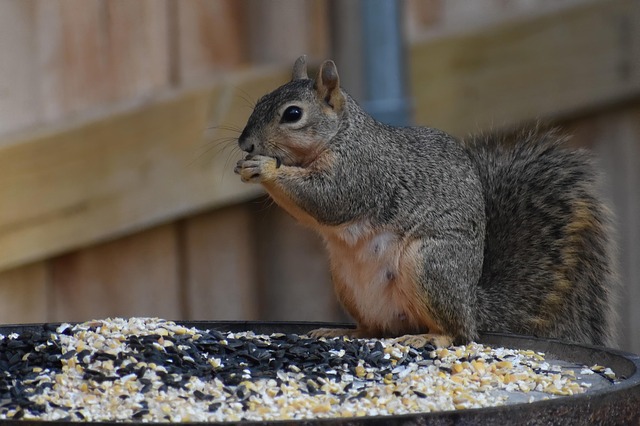Squirrels, with their agility and curiosity, often get trapped in structures due to their exploration habits. Humane squirrel control is key to managing these situations, focusing on safe capture and relocation using live traps with appealing baits. After successfully moving squirrels, preventing future intrusions involves sealing entry points, maintaining a clutter-free environment, and conducting regular inspections. Prioritizing humane methods ensures the safety of both squirrels and individuals, fostering peaceful coexistence with wildlife.
Learn how to safely handle and relocate trapped squirrels with this comprehensive guide. Understanding squirrel behavior is key to effective humane squirrel control. Discover why they get caught, what equipment to gather for their safe relocation, and step-by-step instructions on trapping. Additionally, explore aftercare tips and prevention strategies to avoid future incidents. Implement these practices for ethical and compassionate humane squirrel control.
Understanding Squirrel Behavior and Why They Get Trapped
Squirrels are intelligent and agile creatures, known for their quick reflexes and sharp senses. However, this same nature often leads them to get themselves into tricky situations, such as getting trapped in spaces like attics, walls, or closed-off rooms. Understanding squirrel behavior is crucial when it comes to humane squirrel control. They are highly curious and will often explore new areas, which can result in them venturing into spaces they cannot easily escape from.
These small mammals have excellent climbing abilities, but their size can make it challenging for them to navigate narrow openings or vertical surfaces once they’re trapped. Their natural instinct is to seek shelter and food sources, so they may enter buildings through open windows or gaps in search of a warm place to rest or acorns to store. When faced with an unexpected barrier, squirrels might panic and become stuck, leading to their entrapment. Humanely handling these situations involves recognizing their behavior patterns and using strategies that encourage them to escape unharmed.
Gathering the Right Equipment for Humane Relocation
When it comes to relocating trapped squirrels, safety and compassion are paramount. The goal is to ensure both the well-being of the animal and a smooth transition for it into its new environment. To achieve this, gathering the right equipment for humane squirrel control is essential. A gentle, yet secure, carry case designed specifically for small animals is a must. This container should have adequate ventilation and a snug fit to prevent escape attempts during transport. Additionally, having a warm blanket or towel can provide comfort and insulation, especially during cold weather.
Extending beyond the physical supplies, it’s equally important to prepare mentally. Approach the process with patience and care, as squirrels can be stressed by their confinement. Slow, deliberate movements and soft tones can help calm the animal. Remember, humane squirrel control is about finding a solution that respects both the creature’s needs and your safety, fostering a harmonious coexistence between humans and wildlife.
Safe Steps to Trap and Relocate a Squirrel
When dealing with trapped squirrels, it’s crucial to employ humane squirrel control methods that ensure their safety and well-being. The first step is to identify where the squirrel has taken refuge—look for signs of entry points such as holes or gaps in walls, attics, or trees. Once located, avoid direct contact; squirrels can carry diseases and cause damage if agitated.
Instead, use live traps designed specifically for squirrels. These traps capture the animal without harming it, allowing for safe removal. Set the trap near the known entry point with a bait that appeals to squirrels, like nuts or peanut butter. Check the trap regularly, preferably in the early morning or late evening when squirrels are most active. Once caught, handle the squirrel gently and place it in a box with ventilation holes for transport. Contact local wildlife authorities or professional animal handlers for relocation to a suitable forest habitat away from urban areas.
Aftercare and Prevention Tips for Future Incidents
After successfully relocating trapped squirrels, it’s crucial to consider aftercare and prevention tips for future incidents. One of the primary aspects is ensuring the squirrels’ well-being post-relocation. Check the area where they were found to ensure there are no remaining threats, such as pets or other potential hazards. Provide a safe haven or nesting box nearby to allow them to reorient and adjust to their surroundings without immediate pressure to find food or shelter.
To prevent future incidents, implement humane squirrel control measures. This includes sealing off entry points into your home or structure using hardware cloth or similar materials, ensuring all vents and openings are secured. Regularly inspect your property for any signs of squirrel activity, such as chewing or droppings, and address these issues promptly. Tree trimming and maintaining a clean, clutter-free yard can also deter squirrels from seeking shelter in your area.
When dealing with trapped squirrels, it’s essential to employ humane squirrel control methods that prioritize the animal’s well-being. By understanding their behavior and using the right equipment, we can safely relocate them, ensuring a positive outcome for both the creature and the environment. Following these steps not only helps protect squirrels but also reduces the risk of future incidents, fostering a harmonious coexistence between humans and wildlife.
